6 best soy protein

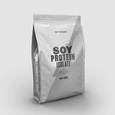
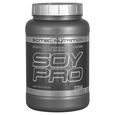


Soy is often blamed for many sins. But what really represents this mysterious product and what is its secret? Read about it, as well as what is the best soy protein in our ranking.
Types of Soy Protein
The main protein-containing soy preparations are:
- flour,
- concentrate,
- isolate
as well as textured soy protein.
The first three product groups differ from each other in the amount of protein per 100 g of product. The smallest amount of protein is contained in skim flour - about 52-59% of the total volume of the product.
Then comes the soy concentrate with a protein fraction of about 65-72%. Isolated soy protein is considered the most concentrated drug with a share of protein in it 90-92%.
Soy flour
It is made from soybeans both before and after pressing the oil. Soy flour is widely used in the food industry. In particular, in the production of sausages, canned food and pates, in bread baking, as well as in the manufacture of food for animals.
Soy concentrate
Like soy flour, it is made from low-fat soybeans, but most of the soluble non-protein components are removed from the concentrate. There are three types of soybean concentrate:
- traditional (obtained by acid or water-alcohol extraction),
- combined (traditional concentrate with a thickener, for example, guar flour, which improves the water holding capacity of soy protein),
- highly functional (hydrothermally processed traditional concentrate, having the best solubility and water-holding properties).
By functional properties, the latter is not inferior to soy isolates.
Soy isolate
The most used soy protein. Like the concentrate, it is made from fat-free soybeans, but almost all non-protein components are missing from the isolate.
Isolated soy protein is purified from carbohydrates and soy fats, it has no fiber. The isolate is highly soluble and has no specific odor, and also has a neutral taste.
Textured Soy Protein
It can be made from any soy preparation, but most often it is made from low-fat flour. In essence, texturate is a special product created by cooking soy dough to imitate the texture of the most valuable food products.
Widely known Soy meat - this is textured soy protein. It has the fibrous structure of meat and is able to absorb all tastes and aromas. Therefore, texturate is commonly used as a substitute and analogue of meat in the manufacture of, for example, sausages, pies and other meat-containing products.
Before cooking, soy texturate must be soaked or boiled in water or broth. After that, the mass of the original product increases several times.
The benefits of soy protein
Cost of
Soy protein is much cheaper than meat and dairy products. For example, 1 kg of soy meat costs about 150 rubles. And this is despite the fact that after soaking texturate increases in volume by 2-3 times.
Cellulose
Since soy is a plant, it contains fiber, i.e. alimentary fiber. This component is not digested by the human body, but is food for beneficial intestinal microflora, which is good for comfortable digestion.
No lactose
Makes soy an ideal product for those people who have lactose intolerance (milk sugar), as well as for vegetarians. In addition, soy is an ideal high protein lean product.
A complete amino acid profile and a rich composition of essential elements for the body is also an advantage of soy over other vegetable proteins.
Deficiencies of soy protein
The following properties of soy protein should not be considered severe shortcomings. Because all the topics described here are ambiguous.
Low digestibility and digestion speed
Like any other vegetable protein, soy has a lower digestibility compared to animal proteins.
This means that about a fifth of the soy protein eaten cannot be used by the body. At what points is it a plus? For example, while losing weight. This means that eating 100 grams of soy, the body does not get all 380 calories. However, it is this amount that will be recorded and recorded in the nutrition diary. Thus, the necessary calorie deficit will be fulfilled with a margin.
At the same time, this feature of soy protein can become an obstacle in the way of mass set. Since in this case, it is critical is the excess calories. therefore when building muscle mass soy protein is better to use as a fallback, preferring whey proteins.
The same is true of the digestion rate. With weight loss - this is a plus, because the fiber in soy in combination with protein creates a long-lasting feeling of satiety. With mass set, this property of soy is no longer that priority.
Phytoestrogens and their effect on testosterone levels
The most frequently mentioned lack of soy is the presence of phytoestrogens in it, substances of plant origin are similar in structure to estradiol, the female sex hormone.
First, for women - this is a definite plus, because soybeans will be especially useful for them during the menopause period, when the hormones of women begin to change.
Secondly, despite the large amount of research done on the effect of soy on testosterone levels, scientists have still not reached the final conclusions.
Thus, to date, evidence that soy reduces the level of testosterone in men, no. However, the absence of such an effect does not mean the absence of estrogenic activity, which can lead to undesirable effects.
But here it is worth noting that during cooking, soybean phytoestrogens are destroyed almost completely. Therefore, soy protein in the diet of men to be. But in moderation.
Top Soy Protein Ratings
| A place | Name | Rating | Price |
|---|---|---|---|
| 1 | Twinlab Soy protein isolate | 9.9 / 10 | 1 300 |
| 2 | Optimum Nutrition 100% Soy Protein | 9.9 / 10 | 900 |
| 3 | NOW Soy protein isolate | 9.8 / 10 | 1 800 |
| 4 | MyProtein Soy protein isolate | 9.8 / 10 | 1 250 |
| 5 | Geneticlab Soy Pro | 9.7 / 10 | 900 |
| 6 | Scitec Nutrition Soy Pro | 9.7 / 10 | 1 000 |
|
Twinlab Soy protein isolate
1 300 (can, 531 g)
Twinlab as a manufacturer is famous for its scrupulous attitude to its products. Therefore, they approached the production of soy protein with great responsibility. The composition of Soy protein isolate is extremely laconic - soy protein isolate. And no more additives. Does not contain GMOs. The amount of protein per 36-gram serving is 30 g, 1 g of fat and the complete absence of carbohydrates. Mode of application: Dissolve 2 scoops of the product in 200 ml of water. Main advantages:
Minuses:
|
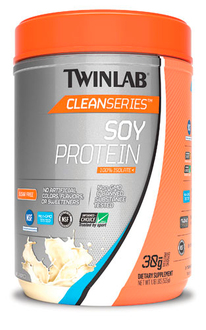 9.9 / 10
Rating
Reviews
Twinlab has the purest soy protein. I have lactose intolerance, so I drink only soy protein, making it a cocktail with soy milk. |
|
Optimum Nutrition 100% Soy Protein
900 (can, 907 g)
Optimum Nutrition Americans produce the best whey proteins in the world. Soy protein shake is no exception. 100% Soy Protein is pure soy protein isolate. In addition to it, the mixture contains only flavor and sweetener. The amount of protein per 30 grams portion is 25 grams, carbohydrates - 2 grams, fats - 1.5 g. Mode of application: Dilute one stingy 100% Soy Protein in 250 ml of water or milk. Main advantages:
|
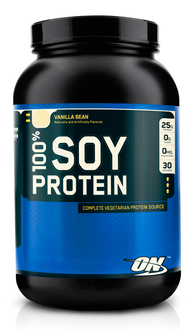 9.9 / 10
Rating
Reviews
Sometimes I make fasting days for myself and drink soy protein cocktails on water instead of whey protein. But I always choose Optimum Nutrition. |
|
NOW Soy protein isolate
1 800 (can, 907 g)
NOW is a famous American manufacturer of dietary supplements. NOW Soy protein isolate does not contain genetically modified products and is based on 90% soy protein isolate. The amount of protein per 45-gram serving is 25 grams, 2.5 grams of fat and 13 grams of carbohydrates, 3 of which are dietary fibers, and 10 grams of fructose. Mode of application: add one stingy to 300 ml of water, cow or vegetable milk. Main advantages:
Minuses:
|
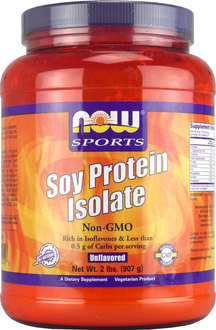 9.8 / 10
Rating
Reviews
I choose this cocktail only during the mass set, because there is just fast sugar, which muscles need after exercise. |
|
MyProtein Soy protein isolate
1 250 (soft package, 1 kg)
The British MyProtein continue to enjoy high-quality inexpensive products. A cocktail of soy isolate will be the best addition to the diet of vegetarians and people with lactose intolerance. 33 g of Soy protein isolate contain 27 g of protein, which indicates a high concentration of raw materials for the production of the product. The amount of carbohydrates per serving - 1.5 g, no fats. Mode of application: Stir 1 quarter in a mixture of 250 ml of water or milk. Main advantages:
Minuses:
|
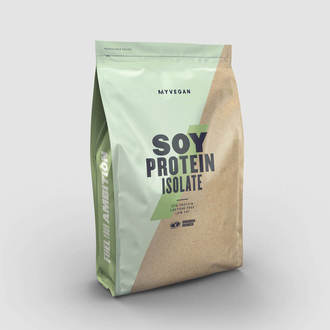 9.8 / 10
Rating
Reviews
I often use this soy isolate during a low-carb diet because it fits my needs perfectly - there is a lot of protein and not enough carbohydrates. |
|
Geneticlab Soy Pro
900 (soft pack, 900 g)
The only Russian product in our ranking of the best soy proteins. Unlike many domestic brands of sports nutrition, Geneticlab make really high-quality products at low prices. Soy Pro consists of soy protein isolate. The amount of protein per 30 grams portion - 23 grams, carbohydrates - 4 grams, fats less than half a gram. Mode of application: mix in a shaker or blender 2 scoops of protein with 300 ml of water. Main advantages:
Minuses:
|
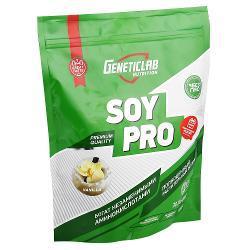 9.7 / 10
Rating
Reviews
Good soy protein from the Russian producer. It could have been more tasty, but the quality of the product is good - everything was digested without any problems. |
|
Scitec Nutrition Soy Pro
1 000 (can, 900 g)
Soy protein of an average price category. Scitec Nutrition has created its product from pure soy isolate, adding soy concentrate to it. This was reflected in the amount of carbohydrates in one portion, there are 5 g. Protein in 28 grams of Soy Pro - 20 g, and fat - 1. Does not contain GMOs. Mode of application: Dissolve one scoop of the product in 250 g of water or other beverage. Main advantages:
Minuses:
|
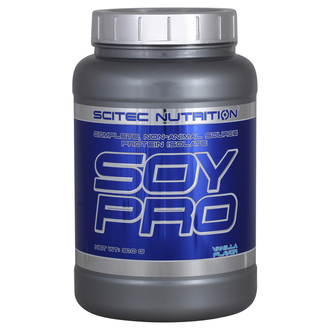 9.7 / 10
Rating
Reviews
As for me, the composition is far from ideal, but in principle it turned out a good soy protein for your money. It thickens rapidly, so I add more liquid than recommended. |
What is soy, its chemical composition and biological value
Soy is an annual herb of the legume family. The food uses soybean seeds, which are also called beans. They are used as raw materials for the production of a wide range of food products: soy meat, milk and cheese, oil and flour, pastes and sauce, and many others.
Chemical composition
100 g of soy contains 35 g of protein, 17 g of fat and 26 g of carbohydrates. This means that soy is a high-protein product with a high content of fat and a small amount of carbohydrates.
The composition of soybean contains linoleic acid - an essential fatty acid of the omega-6 class. It plays an important role for the normal functioning of cellular and subcellular membranes.
In addition to it, soybean contains such important elements as choline and phospholipids. Choline is a precursor of acetylcholine, a neurotransmitter that performs neuromuscular transmission and plays a crucial role in the processes of learning and memory.
Phospholipids are a part of all cellular membranes, and also serve as a source of phosphoric acid, necessary for the person. In addition, they are involved in the transport of fats.
Soy is a raw material for the production of lecithin, which is based on phospholipids. From lecithin in the body, higher fatty acids, phosphoric acid and choline are formed.
Amino acid composition
Soy protein is the only vegetable protein that can be equated to meat in terms of quality and nutritional value. Just look at the amino acid profile of soybeans in order to understand that it contains all the essential amino acids.
Another thing is that compared to animal proteins, soybeans contain less of these essential amino acids. Therefore, talk about the fact that soy protein is deficient in amino acid composition, is wrong.
It is known that in soybean the quantitative content of phenylalanine is 5.2 g per 100 g of protein. While in the whey isolate, the amount of this amino acid is 3 g per 100 g of protein.
At the same time, methionine, one of the most important essential amino acids, contains soy less than all, relative to other amino acids, 1.3 g per 100 g of protein. For comparison, in the egg white, considered to be the reference amino acid profile, methionine contains about 3.5 g per 100 g of protein. Thus, methionine is a limiting amino acid for soy protein, which makes soy is not the most ideal source of protein, but not the worst.
Biological value
Yes, vegetable protein is absorbed worse than an animal. The percentage of digestibility of soy protein is 78, while egg protein is digested by 97%. But at the same time the coefficient of biological value of soy protein is high and equal to 96.
Biological value is a method of measuring the efficiency of the use of protein by the body for the synthesis of its proteins. To determine it, you need to know two quantities - the amount of protein consumed and the amount of nitrogen used and unused by the body.
Based on these data, it is concluded how much of the protein was absorbed and used by the body. Thus, considering the coefficient of the biological value of soy, we can conclude that its protein is used by the body almost one hundred percent.
Another indicator of protein quality is the PDCAAS score. This is an amino acid corrected assessment of protein digestibility. This method also takes into account the amino acid composition of the protein to the ideal needs of the human body according to the requirements of the World Health Organization.
PDCAAS assessment is based on the study of two parameters:
content in the protein alone amino acids,
ease of protein digestion during digestion.
For soy, this figure is 0.91, for egg white - 1, for beef - 0.92. Thus, the PDCAAS score places soy protein at the same level as the quality of egg protein, meat and dairy products.
Soy and GMO
Soy is more often than others accused of unnatural and is considered an artificially created synthetic product. In general, a complete GMO. But as it became clear, soy is a plant.
And by the way, even ordinary potatoes, which gardeners grow in their beds, can also be considered genetically modified. After all, the selection, the result of which many varieties of potato were, is also a kind of genetic engineering.
Genetically modified - means obtained as a result of manipulations with the genome. In such organisms, certain genes have been removed and replaced by others, which tells the plants new properties: resistance to fungal diseases, increased production of certain nutrients, and high yields.
In general, society is not well aware of what genetic engineering is and how it can be useful. At least by the fact that with its help it is possible to solve the problem of hunger arising due to crop losses, depending on weather conditions. No experimentally confirmed scientific data on the dangers of GMOs do not exist. But in the end, everyone chooses how to treat GMOs.






